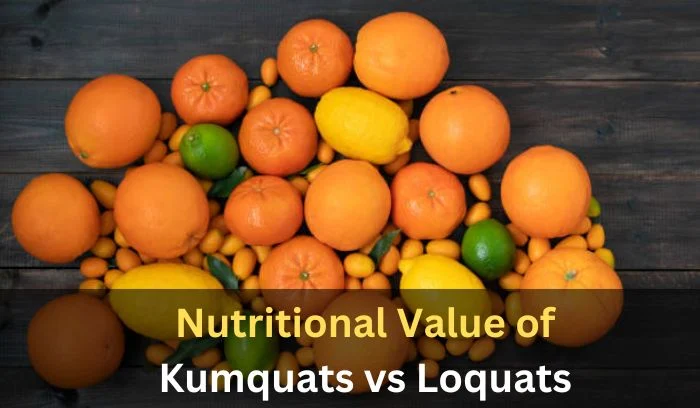When it comes to citrus fruits, kumquat and loquat are two distinct options that often get mixed up due to their similar names. While both are part of the larger fruit family, their characteristics are quite different.
A kumquat is a tiny, oval-shaped fruit with a tart and slightly tangy flavor. What makes it stand out is its sweet, edible peel, which adds a unique touch when you bite into it.
On the other hand, a loquat is larger, more pear-shaped, and has a smooth golden-yellow skin. Its flesh is juicy and offers a blend of sweet and mildly tangy notes, making it ideal for both fresh eating and culinary preparations.
The nutritional profiles of these fruits also differ, with each offering unique health benefits. Kumquats are rich in fiber, vitamin C, and antioxidants, which promote immune function and support digestive health.
Loquats, meanwhile, are a great source of vitamin A, potassium, and pectin, which aid in vision, heart health, and overall digestion. Whether you’re growing them in your garden or snacking on them, these fruits pack a punch with their unique qualities, contributing to your well-being in their own distinct way.
Key Points
| #- | Aspect | Kumquat | Loquat |
|---|---|---|---|
| 1- | Family | Rutaceae | Rosaceae |
| 2- | Shape | Small, oval or round | Pear-shaped or oval |
| 3- | Size | 2-5 cm | Larger, typically 5-8 cm |
| 4- | Color | Bright orange | Yellow to orange |
| 5- | Skin | Thin, edible, sweet | Smooth, inedible peel, yellow-orange |
| 6- | Flavor | Sweet peel with tangy, tart flesh | Sweet and juicy with a hint of tanginess, resembling apricot and peach |
| 7- | Texture | Crisp skin with a firm, juicy interior | Soft, juicy flesh with smooth skin |
| 8- | Taste Profile | Sweet-tart contrast between the peel and flesh | Milder, sweet with slight tanginess |
| 9- | Nutritional Highlights | High in fiber, vitamin C, antioxidants | High in vitamin A, potassium, pectin |
| 10 | Health Benefits | Boosts immune system, aids digestion, reduces inflammation, rich in antioxidants | Supports heart health, improves vision, aids digestion with pectin |
| 11- | Culinary Uses | Eaten raw, in salads, marmalades, jellies, baked goods, paired with seafood and poultry | Eaten fresh, in jams, pies, cakes, fruit salads, smoothies, sauces, baked goods |
| 12- | Storage Tips | Room temperature for up to a week, refrigerate or freeze for longer shelf life | Refrigerate to maintain freshness, freeze for long-term storage |
| 13- | Cultural Significance | Symbol of prosperity and good fortune in Chinese New Year celebrations | Symbol of renewal and spring in Japanese culture |
| 14- | Growing Conditions | Grows in subtropical to temperate climates, tolerates cooler temperatures than most citrus | Thrives in well-drained soil, regular watering, and protection from strong winds |
| 15- | Harvesting | Fully ripe when orange, slightly soft to the touch, picked carefully to avoid bruising | Fully ripe when yellow-orange, soft to the touch, picked carefully |
What Are Kumquats?

Kumquats are a unique type of small citrus fruit that belong to the Rutaceae family. Unlike most other citrus fruits, you can eat the entire fruit, including the peel. These fruits are typically oval or round in shape, with a size ranging from 2 to 5 centimeters in length.
The skin is thin and surprisingly sweet, making it enjoyable to eat without peeling. Inside, the flesh offers a tart and tangy flavor, which perfectly balances the sweetness of the peel. The combination of these flavors gives kumquats a distinct, refreshing taste that’s unlike anything else in the citrus world.
Personally, I’ve found kumquats to be a delightful addition to a fruit salad or even eaten as a quick snack. The ease of eating them whole, without the need to peel or cut, makes them a convenient and healthy choice.
Whether you enjoy them on their own or use them in recipes, the experience is always refreshing, with the sweetness of the peel and the tart tanginess of the inner flesh offering a satisfying balance in every bite.
What Are Loquats?
Loquats, scientifically known as Eriobotrya japonica, are a unique type of fruit that belong to the Rosaceae family. These fruits are native to southeastern China and grow on evergreen trees.

Typically, loquats appear in clusters and have a small, oval, or pear-shaped form. The smooth skin of the fruit ranges from yellow to orange, making it visually appealing. Inside, the flesh is sweet, juicy, and offers a blend of flavors that resemble apricots, peaches, and a hint of citrus.
From personal experience, I’ve found that loquats are not only delicious but also quite versatile. They’re often grown for both ornamental purposes, adding beauty to gardens, and for their fruit-bearing potential, which offers a refreshing snack. Whether enjoyed fresh or used in recipes, their unique taste makes them a favorite for many.
How Do Kumquats and Loquats Taste?
The taste of kumquats and loquats is markedly different from one another. Kumquats have a unique flavor profile where the sweet peel contrasts with the tart flesh, giving you a refreshing burst of citrusy flavor.
This combination makes them a bold, exciting fruit to enjoy in one bite, with the citrusy kick that lingers on your tongue. On the other hand, loquats have a milder, sweeter taste, which feels much softer on the palate.
There’s also a hint of tanginess, often described as a mix of peach and citrus, making it a more subtle, yet equally delightful fruit. From my experience, the flavor of loquats feels like a smoother, juicier blend compared to the bold punch of kumquats.
Appearance of Kumquats and Loquats
When it comes to appearance, kumquats are small and oval, with a bright orange hue that makes them stand out. Their size is similar to a grape, which makes them ideal for snacking.
The thin skin is smooth, and they offer a visual treat when you see them in a bowl or on a platter. Their vibrant color makes them instantly recognizable. In contrast, loquats are larger and pear-shaped, with a soft, smooth skin that comes in shades of yellow to orange.
The visual difference between the two is apparent, and it’s easy to distinguish them at a glance. While kumquats are small and round, loquats have a more elongated form, making them distinct in size and shape.
Nutritional Value of Kumquats vs Loquats
When comparing kumquats and loquats, both of these fruits offer unique nutritional benefits that contribute to a healthy diet. Kumquats are particularly rich in dietary fiber and vitamin C, which are excellent for boosting your immune system and aiding digestion.

They also provide a good amount of antioxidants that help protect the body against harmful free radicals. In contrast, loquats are a great source of vitamin A, which is vital for eye health, as well as potassium which helps maintain proper heart function. Both fruits, though different in their specific benefits, provide vital nutrients that support overall well-being.
The fiber content in both fruits is impressive, making them great choices for those looking to improve their digestive health.
While kumquats are especially known for their rich antioxidant profile and high vitamin C levels, loquats stand out due to their pectin content, which can help lower cholesterol. Whether you choose kumquats or loquats, adding them to your diet can offer nutritional advantages that will help maintain your health and vitality.
What Are the Health Benefits of Kumquats?
Kumquats are small but mighty fruits that pack a punch when it comes to health. They are beneficial for your overall well-being, thanks to their ability to boost your immune system.
With their high levels of vitamin C, they help strengthen your body’s natural defenses, making you less susceptible to colds and infections. Additionally, kumquats are great for improving digestive health. Their fiber content supports smooth digestion, keeping everything running smoothly.
Not only that, but kumquats also offer powerful antioxidants that help your body combat oxidative stress. These antioxidants fight off free radicals, protecting your cells from damage. By doing so, kumquats also help reduce inflammation, which is key in preventing various chronic diseases. Incorporating these fruits into your diet can be a simple and effective way to support your health on multiple levels.
What Are the Health Benefits of Loquats?
Loquats are a fantastic fruit that can do wonders for your health. They are especially known for their ability to support heart health, thanks to their high levels of potassium, which helps regulate blood pressure and maintain proper heart function.
These fruits also contain vitamin A, an essential nutrient for improving vision and supporting eye health. So, adding loquats to your diet can be a simple yet effective way to keep your heart and eyes in great shape.
In addition to these benefits, loquats are a valuable source of pectin, which aids in digestion and makes them a perfect addition to a balanced diet.
Their natural properties make them an excellent choice for improving digestion and promoting overall well-being. Whether eaten on their own or added to your meals, loquats are a healthy and nutritious fruit worth including in your daily routine.
Growing Kumquats and Loquats
Kumquats aur loquats dono he fruit trees hain jo subtropical aur warm temperate climates mein aasani se ugaaye ja sakte hain. These trees are fairly hardy, with kumquats able to tolerate cooler temperatures compared to most citrus plants, making them suitable for a wider range of regions.

On the other hand, loquats thrive in well-drained soil and need regular watering, especially during dry periods. Proper care ensures they grow strong and healthy.
Both trees greatly benefit from adequate sunlight and should be placed in areas where they receive plenty of it. However, they also need protection from strong winds, which can damage the plants. Taking these factors into consideration helps ensure that kumquats and loquats grow well and produce fruit successfully, whether in your backyard or garden.
How to Harvest Kumquats and Loquats
When it comes to harvesting kumquats and loquats, it’s important to do so at the right time to ensure you’re getting the best quality fruit. Kumquats should be fully ripe when picked, which means they’ll have a vibrant orange color and a firm texture.
Phal ko haath lagane par halka naram hona chahiye, lekin itna nahi ke wo gila ya mushy lagay. For loquats, you’ll want to wait until they reach a bright yellow-orange shade and feel soft when gently pressed. When harvesting, gently pick the fruit from the tree using your hand, or if necessary, use sharp scissors or a knife to carefully clip the stem to avoid bruising. You might need to make multiple rounds of harvesting as kumquats and loquats tend to ripen unevenly, so it’s essential to stay aware of their ripening stages.
Handling the fruit with care is crucial. After plucking, make sure to place the fruit in a shallow container to avoid any damage. As for kumquats, varieties like Nagami, Meiwa, and Fukushu are common, each offering a slightly different flavor, but all should be harvested in a similar manner. The ripeness check for loquats is similar:
Unhein poori tarah rangdaar, haath lagane par naram, aur torne ke liye tayar hona chahiye. Be careful not to rush through the process, as each piece should be harvested gently to prevent bruising. Keep in mind that some fruit may ripen at the same time, while others will need extra time on the tree. This is why regular checks and careful handling are necessary to ensure the best harvest for your trees.
What Are the Culinary Uses of Kumquats?
Kumquats are incredibly versatile in the kitchen. You can enjoy them raw, adding a burst of sweet-tart flavor to your dishes. They work wonderfully when added to salads, providing a zesty twist.

One of their most popular uses is in making marmalades and jellies, where their natural sweetness and tanginess shine through. Meethay khanay ke shauqeen logon ke liye, candied kumquats ek lazeez mithai hain jo mazeedaar maza ka behtareen tawazun paish karti hain.
Their unique taste also pairs excellently with poultry and seafood dishes, enhancing the overall flavor profile. Kumquats can even be used in baking, adding an interesting citrus kick to your favorite desserts. From savory to sweet, these tiny fruits elevate any dish they’re included in, making them a must-have ingredient in the kitchen.
What Are the Culinary Uses of Loquats?
Loquats are incredibly versatile in the kitchen, thanks to their sweet, juicy flavor that makes them perfect for a variety of dishes. You can eat them fresh for a quick snack, or use them in desserts like pies and cakes.
Their natural sweetness also makes them ideal for jams and jellies, adding a unique twist to your breakfast spread. If you’re looking to refresh your menu, try adding loquats to fruit salads or blend them into smoothies for a delicious, nutrient-packed drink.
Moreover, loquats can be cooked down into sauces, which pair wonderfully with savory dishes. Their ability to hold up in baked goods like muffins and tarts makes them an excellent choice for home baking. Whether you’re using them in sweet or savory dishes, loquats’ versatility in the kitchen adds a burst of flavor to any recipe.
Kumquat vs Loquat: Which Is Better for Cooking?
When deciding whether kumquats or loquats are better for your cooking, it often comes down to the flavor and texture you’re seeking. Kumquats are known for their sweet-tart profile, making them an ideal choice for enhancing savory dishes with a burst of tangy sweetness.
They are perfect in recipes where you want that unique contrast of flavors. On the other hand, loquats provide a sweet, juicy element that is more suitable for desserts and fresh preparations, offering a mild, refreshing taste that pairs well with fruit salads or smoothies. Each fruit brings a different characteristic to the table, and the choice between them ultimately depends on the dish you’re preparing.
If you’re looking for something with a bit of zing for a savory meal, kumquats would be the right pick, while loquats are great if you want something more naturally sweet for a fruit dish or dessert. The flavor and texture of each fruit make them versatile, but they shine in different culinary contexts.
How to Eat Kumquats and Loquats?
Kumquats are best eaten whole, with their skin on. This makes them a super convenient snack that you can enjoy anytime. The entire fruit, including the peel, provides a delightful combination of sweetness and tang.
On the other hand, loquats need a bit more preparation before you can eat them. First, you should peel the skin and deseed the fruit before consumption. Once prepared, loquats can be sliced and added to dishes or simply enjoyed as a refreshing treat on their own.
Storage Tips for Kumquats and Loquats
When storing kumquats and loquats, the method you choose depends on how long you intend to keep them fresh. For kumquats, they can be kept at room temperature for up to a week, allowing you to enjoy their vibrant freshness. However, if you need them to last longer, placing them in the refrigerator will help maintain their quality and prevent spoilage.
You’ll want to store them carefully, ensuring they’re not exposed to moisture that can cause them to deteriorate faster. If you’re planning to use them for cooking or baking, freezing them is an excellent way to extend their storage. Frozen kumquats are versatile and can be added directly into recipes when needed.
For loquats, it’s best to store them in the refrigerator to keep their juiciness intact and avoid spoilage. The cold temperature slows down the ripening process, helping the fruit maintain its texture and taste for a longer period. Much like kumquats, loquats can also be frozen for extended storage.
Both fruits can be frozen and later used in baking or cooking, offering convenience when you want to prepare dishes at a later time. Whether you’re looking to enjoy them fresh or preserve them for later use, these storage tips will help you get the most out of your fruits.
Kumquats and Loquats in Popular Culture
In Chinese New Year celebrations, kumquats are often seen as a symbol of good fortune and prosperity. Their bright, vibrant color and small, sweet flavor make them a favorite during the holiday, where they are used in various culinary dishes and festive decorations.
Kumquats are cherished for their positive symbolism and their ability to bring good luck in the coming year. In contrast, loquats hold a special place in Japanese culture, where they are strongly associated with spring and the theme of renewal. T
hese fruits are often enjoyed during the early months of the year, marking the shift in seasons and celebrated for their refreshing, aromatic qualities.
Both fruits are loved in their respective cultural and culinary contexts, each adding a unique flavor and cultural significance. Whether it’s the tradition of the kumquats during the Chinese New Year or the use of loquats in the springtime rituals of Japan, both fruits are cherished for their deep cultural connections and positive meanings.
Varieties of Kumquats and Loquats
Kumquat Varieties
When exploring the varieties of kumquats, there are some unique and widely recognized options to consider. Meiwa is known for its sweet and round fruit, while Nagami is the most commonly grown type in the US with its oval shape and tarter flavor. Another interesting variety is Nordmann Seedless, a hybrid of the Nagami, with thinner skin and a more elongated shape. If you’re looking for an ornamental choice, the Hong Kong Wild kumquat is worth mentioning, admired for its aesthetic appeal rather than fruit production.
Loquat Varieties
When it comes to loquats, varieties such as Tanaka, Gold Nugget, and Mammoth are popular, particularly in Hawaii. Obusa, Fusahikari, and Mizuho were introduced in the 1990s from Japan, adding to the diversity of the loquat family.
These fruits, often referred to as Japanese apricots or plums, belong to the rose family, which also includes apples, pears, peaches, and nectarines. Each variety has its own characteristics, from the sweet rind of Nagami kumquats to the unique flavors of Mammoth loquats. Whether you’re growing for taste or decoration, there’s a variety to suit every need.
FAQs
Loquats, also known as Japanese apricots or plums, belong to the Rosaceae family, which includes apples, pears, peaches, and nectarines. In contrast, kumquats are a citrus fruit, more similar to oranges in flavor.
While kumquats are smaller and tarter, loquats are sweeter and juicier, making them distinct in both size and taste. Despite both being delicious, their differences are clear.
Loquat trees are dioecious, meaning they have separate male and female trees. Naram trees pollen peda karte hain, jabke madah trees phal dete hain. Rarely, hermaphrodites—trees with both male and female flowers on the same tree—have been observed. This was noted in a study by Ngulube in 1998.
Kumquats are a small citrus fruit, about the size of a large green olive. Roshan narangi rang ke kumquats talaash karein jin ka chilka bohot khushbudar ho. Some cultivars may be yellow or greenish, but these are less commercially common.
Calamondin, often mistaken for kumquats by backyard gardeners, are small, round, orange fruits. They are a hybrid between a sour mandarin and a kumquat and are mostly grown as ornamentals. Despite their appearance, calamondin has a different flavor, though it is still flavoursome and perfect for making marmalade.
Kumquats are a good source of vitamin C, antioxidants, and fiber. They originated in China and were called “kam kwat” by the Cantonese, meaning “golden orange.” These little gems from the citrus family can be eaten raw, pickled, or candied, offering a burst of flavor in various forms. Known for their small size and tangy taste, kumquats are both a healthy snack and a versatile ingredient.
Final Thoughts
In the ongoing debate between kumquat and loquat, it’s clear that both fruits stand out for their unique qualities. While kumquats bring a bold, tangy taste that’s perfect for those seeking a sharp citrusy punch, loquats offer a sweet, juicy experience that can captivate anyone with their rich, smooth flavor.
These fruits also shine when it comes to their nutritional benefits and culinary possibilities—whether you’re adding them to a fresh fruit salad or using them in cooking, they can truly enhance any dish.
What makes these fruits particularly exciting is their versatility. Both kumquats and loquats can be enjoyed in numerous ways, from simple snacks to complex recipes.
Whether you’re looking to enjoy their nutrients to the fullest or experiment with different uses, both fruits can be a great addition to your diet. Their flavors, though distinct, offer endless opportunities to elevate your culinary experiences, leaving you with a satisfying sense of both variety and allure in your meals.
See Also:
Peony vs Azalea: Which Plant is Best for Your Garden?
What Do Carrot Sprouts Look Like & When Do They Sprout
Potato Growth Stages: How Fast Do Potato Plants Grow?
How Long Does It Take to Grow Bell Peppers in Minnesota? A Complete Guide



